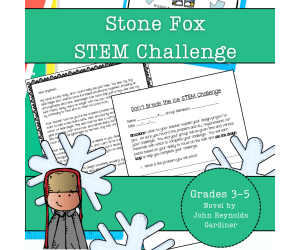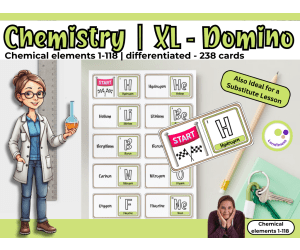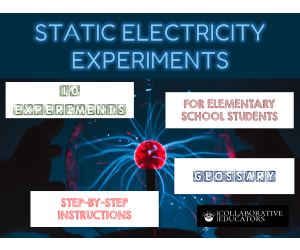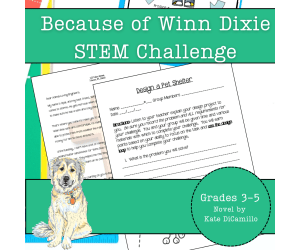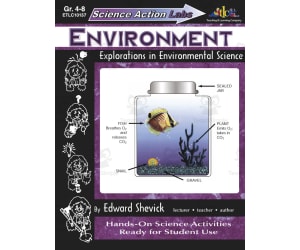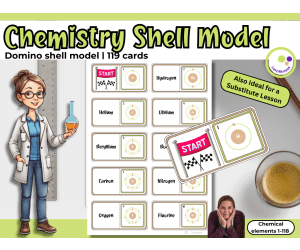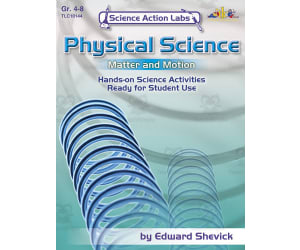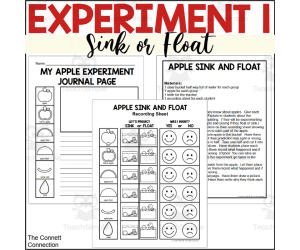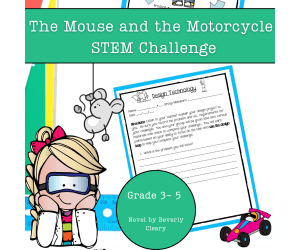Popular Science Experiments
Engage your students with some of the most popular and exciting science experiments. This collection includes classics like volcano eruptions, balloon rockets, and density towers. By incorporating these well-loved experiments into your classroom, you can capture students' interest and make learning science an unforgettable experience.
Stone Fox STEM Experiment + STEM Project for Grades 3, 4, 5
Science, Technology, Engineering, STEM, Grade 3, 4, 5, Experiments, Activities, Projects, Diagrams, Teacher Tools, Graphic Organizers, Rubrics
Little Willy is looking for a way to build a sled that will honor Searchlight, in this STEM project inspired by Stone Fox. This science project encourages problem-solving as students plan and construct a sled that will be able to carry Willy safely across a block of ice. Perfect for blending literature with science, it allows students to explore engineering concepts using simple supplies while promoting teamwork and critical thinking. What’s Inside This Resource: Student Letter: A heartfelt letter from Little Willy introduces the challenge, linking the story to a real-world engineering task. Design Loop Graphic: A visual students can attach to their science journals, serving as a step-by-step guide throughout the activity. Detailed Instructions: Choose to print the guide as a packet or have students record each stage in their journals for an interactive experience. Teacher Tips: Practical guidance for crafting a clear problem statement with time constraints, materials, and success criteria tailored to your classroom. Skills Your Students Will Build: ✔ Problem-Solving: Identify obstacles and create inventive solutions. ✔ Engineering Design: Navigate the design loop—plan, construct, test, and refine. This page can easily be enlarged for a classroom poster. ✔ Critical Thinking: Assess their prototype’s performance and pinpoint ways to enhance it. ✔ Teamwork: Collaborate effectively to accomplish shared goals. Versatile Classroom Application: Whether as guided instruction or part of an integrated literature and science unit, this STEM science project encourages students to think creatively, document their process, and meet science and engineering standards. The rubric included is based on engineering concepts, but can also be used as a nonfiction writing rubric for cross-curricular options. Why Educators Love This Resource: ⭐ “My students were fully engaged, combining their passion for reading with STEM!” ⭐ “Simple to set up and encourages creativity and teamwork.” ⭐ “A seamless connection between literature and science for cross-curricular learning!” Encourage your students to help Little Willy achieve his goals and experience the excitement of engineering with this standards-aligned STEM adventure!
Author Kel's Klass
Tags 4th Grade Science Project, 4th Grade Science Experiment, 5th Grade Science Project, 5th Grade Science Experiment, Engineering Diagram, Science Graphic Organizer, Science Rubric, 3rd Grade Science Project, 3rd Grade Science Experiment, Stone Fox
XL Domino – Chemical Elements 1–118 | exploring element names + symbol
STEM, Science, Chemistry, Physics, Life Sciences, Montessori, Basic Science, Grade 7, 8, 9, 10, 11, 12, Activities, Games, Worksheets & Printables, Task Cards, Quizzes and Tests, Teacher Tools, Word Problems, Flashcards, Escape Room, Experiments
XL Domino – Chemical Elements 1–118 An interactive domino game for exploring element names and symbols 🧪🎲 This printable XL domino game offers a fun and flexible way for students to practice the names and symbols of all 118 chemical elements. Designed for use in grades 7–10, this resource supports both introductory lessons and ongoing review in chemistry class. Whether used in small groups, as a full-class activity, or even spread out along the hallway floor, it encourages active learning and collaboration. Each card features either the name or the symbol of a chemical element. By matching these correctly, students build a long domino chain – all while reinforcing their knowledge of atomic numbers, symbols, and the layout of the periodic table. What’s included: 238 printable domino cards (PDF format) Two complete versions of the game (119 cards each): – Beginner version: element names on both sides – Advanced version: name on one side, symbol on the other Covers all elements from hydrogen (1) to oganesson (118) Tips for setup and gameplay included How I’ve used it: This game works well before introducing the periodic table in depth. It gives students time to get comfortable with element names and symbols in a low-pressure setting. The larger card format makes it ideal for group work or movement-based activities, such as arranging the cards on the floor or in the hallway. Why it works: The visual repetition and active gameplay help students internalize key facts more effectively than passive memorization. Group dynamics also support peer learning – students naturally help each other recall unfamiliar elements. And because it feels like a game, students stay engaged longer and show more willingness to participate. The material is easy to prepare: print, laminate if you like, and cut out the cards. From there, you can adapt it for differentiated learning levels or turn it into a competitive classroom challenge. This is not just a game – it’s a versatile teaching tool that brings the periodic table to life. 📍 Best wishes, Heike from @Lernfitness Did You Know? I teach with a certified therapy dog, and together we create a positive and welcoming learning environment. 🐶
Author Lernfitness
Rating
Tags Educational Card Games, Chemistry, Physics, STEM Science Matching Game, Chemical Elements, Periodic Table Matching Game, Game, Domino, Differentiation
Static Electricity Experiments for Elementary School
Physics, Science, Grade 1, 2, 3, 4, 5, Labs, Experiments, Activities
What is electrostatics, or static electricity? The buildup of electric charge on an object's surface is called static electricity, or electrostatics. This charge, which can be either positive or negative, is produced when a material's atoms acquire or lose electrons. When two objects rub against one another, electrons are transferred from one to the other, creating this static energy. As a result, one of the materials has a negative charge due to an excess of electrons, while the other material has a positive charge due to a lack of electrons. The feeling of a tiny electric shock after stepping on a rug and then contacting a metal surface is a typical example. Ten extremely basic and doable experiments that use or create static electricity are included in this useful e-book. Every experiment is safe and may be carried out using normal, commonplace items. Every experiment has comprehensive, step-by-step instructions. Lastly, each experiment is given a brief explanation so that elementary school pupils can understand it. Have fun exploring the marvels of static electricity through experimentation!
Author Bright Classroom Ideas Marketplace
Rating
Tags Static, Electricity, Experiment, Elementary, Science, Physics
10 Plant Experiments for Elementary School
Nature & Plants, Life Sciences, Science, Grade 3, 4, 5, Labs, Experiments, Activities
These ten easy and entertaining plant experiments make science come to life. Students test the effects of soil, water, and light on plant growth in small groups. They observe how plants bend toward light, watch seeds grow, and watch celery drink colored water. Easy-to-find supplies and precise, detailed instructions are used in each experiment. The lesson teaches practical science skills like forecasting, observing, and documenting data while fostering curiosity and teamwork. Students can ponder, write, and reflect on what they observe with the help of the associated worksheet. To keep every student interested and involved, teachers can set up alternating experiment stations. The worksheet concludes with the answers. Although it can be modified for younger or older students, this curriculum is ideal for Grades 4-5. It links classroom instruction to nature and promotes experiential learning. This ready-to-use, low-prep lesson will add interest to your science class and allow your children to experiment, discover, and develop a love of plants!
Author Bright Classroom Ideas Marketplace
Rating
Tags Plant, Experiment, Lab, Biology, Botany, Elementary, Grade 4, Grade 5
Because of Winn Dixie STEM Experiment + STEM Project for Grades 3-5
Science, Technology, Engineering, STEM, Grade 3, 4, 5, Experiments, Activities, Projects, Diagrams, Teacher Tools, Graphic Organizers, Rubrics
Engage your students in a hands-on STEM challenge inspired by Because of Winn-Dixie! This exciting activity combines engineering, creativity, and problem-solving as students design and build a pet-friendly shelter for Winn-Dixie, the lovable dog who’s afraid of storms. Perfect for blending literature with science, this challenge encourages young minds to apply engineering principles using simple materials, all while developing teamwork, critical thinking, and innovation. What’s Included in This Resource: Student Letter: An engaging letter from Opal invites students to participate in the challenge, drawing a direct connection between the story’s problem and the real-world task. The Design Loop Visual: This visual aid is a great tool for students to glue into their science journals for easy reference. It can easily be enlarged as a classroom poster. Step-by-Step Directions: Detailed instructions that can be printed or written into science journals for a hands-on approach. These directions ensure that students stay on track while working through each part of the challenge. Teacher Notes: Helpful guidance to assist you in creating a clear problem statement, establishing success criteria, and setting time limits and materials. Tailor these instructions to fit your classroom’s needs. Key Skills Developed: ✔ Problem-Solving: Encourage students to identify challenges and develop creative, effective solutions. ✔ Engineering Design: Teach the design process by having students follow the design loop to plan, construct, test, and refine their pet shelters. (Discussing area and perimeter will enhance this design specifically.) ✔ Critical Thinking: Help students evaluate their designs, analyze their prototypes, and identify ways to improve them. ✔ Collaboration: Foster teamwork as students collaborate to achieve a common goal. Flexible Classroom Use: This STEM challenge is perfect for guided instruction or as part of a broader literature and science unit. It provides an opportunity for students to connect their love of reading with real-world applications, improving both their scientific knowledge and creative abilities. Why Teachers Love It: ⭐ “My students were so engaged! It brought their love for reading into STEM learning.” ⭐ “This activity is simple to set up and promotes creativity and teamwork.” ⭐ “The combination of literature and science created an ideal cross-curricular experience for my class.” Inspire your students to help Winn-Dixie solve his stormy dilemma and ignite their passion for engineering with this fun, standards-aligned STEM challenge!
Author Kel's Klass
Tags 4th Grade Science Project, 4th Grade Science Experiment, 5th Grade Science Project, 5th Grade Science Experiment, Engineering Diagram, Science Graphic Organizer, Science Rubric, Because Of Winn Dixie, 3rd Grade Science Project, 3rd Grade Science Experiment
Photosynthesis Lesson and Experiment for 3rd and 4th Grade Science
Science, Nature & Plants, Life Sciences, Earth and Environmental Sciences, Earth Sciences, Grade 3, 4, 5, Centers, Activities, Labs, Experiments, Worksheets, Worksheets & Printables
Photosynthesis Lesson, Worksheets, and Experiment How Plants Make Food - 3rd & 4th Grade Science Lesson I created this resource to give students a clear and enjoyable introduction to photosynthesis. The lesson blends reading, discussion, and a hands-on experiment so students can see how plants make their own food in a way that feels real and meaningful. I put this resource together because photosynthesis is one of those topics that becomes much easier to understand when students can read about it and observe it in action. This set offers a mix of activities that help students explore the idea from different angles. What’s inside? A short reading passage that explains photosynthesis Seven comprehension questions with an answer key A step by step experiment using black gram seeds Follow-up discussion questions to guide class conversation Safety notes and cautions for the experiment Two anchor charts that break the process into small pieces A quick True/False activity with answers A diagram activity where students label the photosynthesis process A story-writing page where students write from the point of view of a plant Complete answer keys to all the questions are included in this resource Resource features: I designed this set with 3rd and 4th graders in my mind. The reading level and activities are approachable for that age group. The experiment inside the resource is simple enough for students to complete in small groups, but still gives them something meaningful to observe. I have written all the instructions clearly. Each activity in this resource builds on the previous one so students can connect ideas as they go. This resource also blends science with literacy, drawing, and creative thinking, which makes it easy to fit into a variety of lesson plans or science centers. Ways to use it: Reading activity: Have students read the passage and answer the questions independently or with partners. Vocabulary work: Create a small word wall or glossary for science terms. Hands-on learning: Set up the seed experiment as a class or rotate it through small groups. Science journals: Encourage students to record their predictions and observations throughout the experiment. Art activity: Students can draw and label the parts of a plant involved in photosynthesis. Writing prompt: Let students write a short story from the perspective of a plant creating its own food. Group talk: Compare observations, discuss results, and talk through what might have caused them. Extensions: Students can look at different types of plants and explore how sunlight and environment affect their growth. Usefulness for teachers, homeschoolers, and parents This resource works well as a mini-unit as it requires very little preparation. The activities give students different ways to understand the process of photosynthesis. This resource is suitable for a wide range of learners. It supports reading comprehension, science vocabulary, and basic scientific inquiry skills, all while keeping instructions simple enough for independent use. The experiment uses easy to find materials, and the activities make it simple to incorporate science into home learning or family projects. photosynthesis, 3rd grade science, 4th grade science, anecdotal activity, photosynthesis story, hands-on learning, plant science, reading comprehension, science experiments, STEM, elementary education, homeschool science, nature study, scientific inquiry, vocabulary building, cross-curricular learning, environmental education, chlorophyll experiment, plant growth, science journaling, critical thinking, observation skills, teaching resource, environmental science, anchor charts, photosynthesis experiment
Author FlashKart
Rating
Tags Science, Photosynthesis, Plants, 3rd Grade Science, 4th Grade Science, Photosynthesis Experiment, Science Reading, Sunlight, Science Process, Earth Science
Water Cycle Earth Science Activity
Earth and Environmental Sciences, Science, Earth Sciences, Environmental Science, Grade 2, 3, 4, Experiments, Activities, Diagrams, Teacher Tools, Lesson Plans, Templates
I created this water cycle science activity for young students who are beginning to learn how water moves through Earth’s systems. Each page focuses on a simple part of the water cycle, including evaporation, condensation, precipitation, and collection. The worksheets include clear diagrams, short explanations, and guided activities so students can understand the concept without feeling overwhelmed. This type of activity works well during science lessons, especially when students are being introduced to Earth science topics. It can be used as a whole-class activity, a science center, morning work, or extra practice after a lesson. I’ve used similar worksheets before, and students enjoy labeling diagrams and following the steps of the water cycle from start to finish. The pack is easy to print and works well in both color and black-and-white. It fits nicely into classroom routines and can also be used at home for review or reinforcement. What’s included: 11 printable water cycle worksheets Clear and simple water cycle diagrams Activities covering evaporation, condensation, precipitation, and collection Kid-friendly science illustrations Suitable for grades 1–3 Great for individual, partner, or small-group work
Author Bright Education
Rating
Tags Science, Water Cycle, Earth Science
Science Action Labs Environment: Explorations in Environmental Science
Science, Earth and Environmental Sciences, Environmental Science, Grade 4, 5, 6, 7, 8, Labs, Experiments, Activities
Science Action Labs Environment: Explorations in Environmental Science This comprehensive teaching resource is designed to bring science to life for Grade 4 to 8 students. The toolkit offers an interesting adventure into environmental science, provoking students to engage deeply with various scientific problems. Main Features: The resource primarily focuses on different scientific mysteries which can be applied in a variety of classroom settings. It can be used as part of whole-group instruction, in small study groups or even assigned as homework, opening doors for differentiated learning. Gives both teachers and students the freedom to experiment with a wide array of scientific concepts without feeling overwhelmed. Provides ample opportunities for promoting active learning through hands-on experience. Molding Young Minds: Students are encouraged to use their thinking abilities and problem-solving skills vastly while navigating through these intriguing scientific puzzles. It triggers interest about environmental science subjects via engaging labs thereby fostering deeper understanding amongst the youngsters. Syllabus Compatibility and Approachability: The toolkit contains 64 ready-to-print PDF pages packed with practical content making it align perfectly with core Environmental Science syllabus common at primary schools. Additionally, the easy-to-comprehend language used throughout this resource accommodates varying reading abilities present within those grades. Educational Impact This tool truly simplifies intricate ideas and facilitates children approach them at their own pace under guided supervision from educators. By integrating this aid into lesson planning - educators could considerably boost classroom discussions around logical reasoning all while effectively sparking intellectual growth among budding learners over time.' Lasting Influence: Habitual usage of this dynamic resource not only amplifies student engagement but also succeeds to instill critical-thinking skills crucial in developmental years leading up towards higher education—making education substantial and nourishing at every step.
Author Classroom Complete Press
Tags Environmental, Science, Action Labs, Explorations, Science Activity
Atomic Shell Model Domino – Learning Electron Configurations Play
STEM, Science, Chemistry, Physics, Life Sciences, Montessori, Basic Science, Grade 7, 8, 9, 10, 11, 12, Activities, Games, Worksheets & Printables, Task Cards, Quizzes and Tests, Teacher Tools, Word Problems, Flashcards, Escape Room, Experiments
Atomic Shell Model Domino – Learning Electron Configurations Through Play 118 cards for learning the periodic table A classroom game to practice atomic structure and element knowledge 🧪🎲 This printable domino game helps students explore the shell model of the atom while getting to know the periodic table in a more hands-on and interactive way. Each card connects an element name to a visual of its electron shell configuration, offering a playful way to reinforce key chemistry concepts. The set includes 119 domino-style cards – covering all 118 known elements. On each card, the element name is on the left and the corresponding shell diagram with its symbol is on the right. Students link them by matching the shell model of one element to the name of the next. It’s a surprisingly effective way to help them recognize patterns in atomic structure, get familiar with chemical symbols, and connect abstract content to something more tangible. What’s included: 119 printable domino cards (PDF) Each card shows: element name → electron shell model with element symbol Print-ready format; laminating optional but recommended Classroom ideas: Use as a full-class activity or in small groups Introduce the game before formal work with the periodic table to build foundational understanding Great for movement-based tasks: spread the cards across tables or even down a hallway Set time challenges: Who can build the longest correct domino chain? For easier levels, use a reduced set (e.g., first 20 elements or just the main groups) In my chemistry classes, students enjoy the game format – especially those who don’t usually connect with abstract models. Working together to build the correct sequence gives them a chance to talk through the structure of atoms and test their understanding in a low-pressure setting. The domino format encourages active learning, peer interaction, and multiple ways to differentiate by level. Whether you use the full set or simplify it for younger learners, it’s a great way to bring more movement and discussion into your science lessons. Just print, cut, and you’re ready to play. 📍 Best wishes, Heike from @Lernfitness Did You Know? I teach with a certified therapy dog, and together we create a positive and welcoming learning environment. 🐶
Author Lernfitness
Rating
Tags Educational Card Games, Chemistry, Physics, STEM Science Matching Game, Chemical Elements, Periodic Table Matching Game, Shell Model, Game, Domino
Refraction – Lab Station Activity
Science, Physics, Grade 7, 8, 9, 10, Labs, Experiments, Activities
Refraction – Lab Station Activity is a physics teaching resource for educators to engage students in hands-on learning. Through nine interactive stations, students explore key concepts like apparent depth, index of refraction, and more. Activities range from creative drawing prompts and videos to answering knowledge checks and writing explanations. This self-directed 30-45 minute lab gives students exposure to real-world examples while providing built-in support materials like reading passages, answer keys, word games, and recording sheets to keep students focused. Teachers can implement whole-class, but sessions also work for small groups or independent practice. This multifaceted refraction lab is one module in a physics series exploring concepts like motion, energy, light, sound, and flight through inquiry-based activities customizable for grades 7-10.
Author Teach With Fergy
Tags Refraction, Speed, Light, Physics, Lab Station, Refraction Of Light Lab
Science Action Labs Physical Science: Matter and Motion
Science, Physics, Grade 4, 5, 6, 7, 8, Labs, Experiments, Activities
Science Action Labs Physical Science: Matter and Motion An essential teaching resource designed for educators of Grade 4 to Grade 8 students with a primary focus on Newton's First Law of Motion. This versatile science guide forms the foundation for a range of engaging activities. Lessons grounded in physical science, revolving around essentials such as matter and motion. Characteristics of matter, friction integration and understanding concept made effortless with this pragmatic resource. Actionable Labs The many engaging projects include: Building simple pendulums. Creating miniature scenarios to demonstrate overcoming friction. The activities introduce novel methods to explore conventional concepts through active learning. This affluence in implementation strategies meets varying teaching needs from whole group instruction to individual assignments based on the class or student requirements. Ease of Use The constructively organized PDF entails: A ready-to-print format containing 64 straightforward pages - easing preparation time with well-designed activities available at your fingertips! To summarize,, "Science Action Labs : Physical Science - Matter And Motion" strikes an effective balance between theory and practice cultivating an active learning environment for conceptual mastery via real-world application focused hands-on activities.
Author Classroom Complete Press
Tags Hands-on Science, Edible Atoms, Mousetrap Science, Momentum Challenge, Inertia
Nonrenewable Energy Sources Lab Station Activity
Science, Chemistry, Grade 5, 6, 7, 8, 9, 10, 11, Labs, Experiments, Activities
Nonrenewable Energy Sources Lab Station Activity An expressive teaching resource fashioned to infuse active, hands-on learning in your science classroom. This Lab Station Activity is an engaging, interactive dive into nonrenewable energy sources and their impacts. It is tailored for grades 5 to 11, aligning with the NGSS standards MS-ESS3-4, MS-ESS3-5, and HS-ESS3-4.. Educational Approach The activity embraces a diversified approach, integrating multiple modes of learning at each stage. This not only ensures student involvement but also caters for all kinds of learners regardless of their strength or preferred style. Fields covered include biomass, fossil fuels, and nuclear energy among other topics; along with electricity generation and global warming aspects that highlight real-world application. The Stations Set Up: Drawing/Building: Students engage in creative processes at this station. Tutorial Hunt: Here, students find answers to specific questions surrounding non-renewable energy. Perspective Sharing:Socratic-style interaction where students give written opinions/thoughts on certain issues mentioned in prompts given. Literacy Appraisal: Hones reading comprehension as students explore topical news about real life implications of non-renewable energy sources. Knowledge Test : Learners assess self-understanding through multiple choice questions related to the subject matter . Exciting Multimedia : Students engage with short, educational video clips about non-renewable energy sources and try to answer questions based on these Additional Complementary Activities : To ensure the energetic tempo is unbroken while transitioning between stations, this activity includes: word searches and word scrambles. User-Friendly Format : The product comes in an easy-to-use format that requires minimal prep—just print out the cards and distribute them around your classroom! It's fully editable so you have leeway to make it relatable to your teaching style or class needs. An answer key likewise avails a compact verifying tool for responses when needed. Pedagogical Flexibility : This active learning tool provides flexibility by catering for large-group instruction during class time as well as small collaborative groups. It can also be given as homework for individual students .
Author Teach With Fergy
Tags Nonrenewable Energy, Lab Station Activity, Hands-on Learning, NGSS-aligned, Interactive, Energy Labs Middle School
Apple Science Experiment - Sink or Float
Fall, Seasons, Holiday & Seasonal, Basic Science, Science, Nature & Plants, Life Sciences, Kindergarten, Preschool, Grade 1, Experiments, Activities
Make learning about apples fun with this apple science experiment. Students will practice making predictions, conducting an experiment, and recording their results with this apple sink or float experiment. What is Included: There is a detailed instructional page that provides detailed instructions for the experiment, a materials list needed, and any special tips or optional activities to complete with this experiment. There is a recording page with easy to follow directions for students to draw or color their predictions and record the results of the experiment. There are two journaling pages students can use to record their results and write about what they observed during the experiment. One journal page includes picture clues to guide students in their responses, while the other is a simple journal page for students to draw whatever they wish and then write their responses. What is the Experiment? This experiment is an apple sink or float experiment. Students will use a whole apple as well as different parts of an apple to see if they sink or float in a bucket of water. This experiment allows students to learn about buoyancy. How to Use: Students can work in small groups of 2 or 3 to complete this experiment. The teacher may also choose to lead the experiment with the whole group of students. Each method allows students to make predictions and record results on their own. This science experiment is perfect for young learners. The easy to follow instructions and scaffolded recording and journaling pages help students through completing the experiment. While setting up the experiment does take material and time to do, the recording pages and journaling pages are no-prep, making this an easy activity to prepare for students. The low prep experiment is a great addition to any busy classroom or home school environment.
Author The Connett Connection
Rating
Tags Apple Science, Apple Science Experiments, Science Experiment, Elementary Science, 1st Grade Science Experiments, Kindergarten Experiments, Kindergarten Science Projects, Science Experiments For Kids
Earthquakes and Volcanoes - Lab Station Activity
Science, Earth and Environmental Sciences, Environmental Science, Grade 6, 7, 8, 9, 10, Labs, Experiments, Activities
Earthquakes and Volcanoes Lab Station Activity Bring earthquakes and volcanoes to life in your middle or high school science classroom with this engaging lab station activity . Students will rotate through 9 stations, each offering a unique hands-on opportunity to build their knowledge. Activities include designing models, conducting research, answering discussion questions, analyzing readings and videos, and more. The activity covers key concepts like fault lines, earthquake prediction, volcanic eruptions, and the connection to real-world events. It aligns to multiple NGSS standards. Includes station description cards, student recording sheets, and answer keys for easy implementation. Challenge your students to think critically about earthquakes and volcanoes while keeping them actively engaged with this multifaceted, high-interest lab. Download, print, and start shaking up your science lessons today!
Author Teach With Fergy
Tags Earthquakes, Volcanoes, Natural Disasters, Weather, Lab Station, Volcanoes Lab, Earthquake And Volcano Worksheets
Cancer – Lab Station Activity
Science, Life Sciences, Biology, Grade 8, 9, 10, 11, Labs, Experiments, Activities
Cancer – Lab Station Activity This is a dynamic and engaging resource designed to enhance student understanding around the scientific complexities of cancer. It's characterized by its flexibility, effectively catering to different learning styles through various interactive tasks and exercises. Primarily intended for Grades 8-11 biology education. The activity revolves around seven unique lab stations. Every station includes an instruction card; some provide detailed prompts or reading material. Students use a record sheet (passport) at each station for recording responses, encouraging active engagement with the content. Detailed Exploration of Cancer-related Topics This comprehensive product delivers more than just scientific facts about cancer. It elaborates on aspects ranging from metastasis and causes to prevention strategies and treatment options - stimulating critical thought about the broader context of cancer in healthcare. Versatile Classroom Application Apart from being a lab activity , these versatile cards can be used for review sessions before tests or quizzes as well. Rotating between stations helps keep boredom at bay while maintaining consistent learning outcomes. Bonus Activities Included A word scramble and word search puzzle are included as fun extras - no idle moments while waiting between rotating stations! Educator Discretion & Personalization List item The formatting is fully customizable according to individual class needs. Can cater to stronger students with word scrambles whilst supporting weaker ones with simpler word searches. Ensures minimal preparation time without any compromise on learning outcomes.
Author Teach With Fergy
Tags Cancer Education, Lab Activity, Interactive Learning, Critical Thinking, Healthcare, Cancer Lesson Plans High School
Proteins and Nucleic Acids – Lab Station Activity
Science, Chemistry, Grade 7, 8, 9, 10, Labs, Experiments, Activities
Proteins and Nucleic Acids - Lab Station Activity An interactive resource for Grade 7-10 teachers enabling students to dive deep into the world of Thermoregulation. Extremely engaging with several elements: Drawing or building challenges. Online research questions. Space for expressing opinion writings on temperature regulation topics. Inclusive rest stations inbetween tasks. Note: These activities are designed so that they stimulate higher-order thinking, linking academic concepts with real-life applications. Assessment Components The lab activity also includes targeted assessments such as: Multiple Choice Questions: Providing thoughtful explanations behind their chosen solutions. Mastership Task: A station where they create two multiple-choice questions from true/false categories and a short answer query inclusive of supplying accurate answers as well. The entire lab activity is seamless for instructors; printing cards and scattering them around the learning space is all it takes. A supplied answer key adds convenience during assessment phases. Bonus Activities! To keep the engagement lively, this resource offers bonus games like a word scramble puzzle and a word search game ensuring no room for idle intervals among learners. Fruitful Knowledge Outcomes & Future Topics The resource is dedicated towards achieving solid understanding about Thermoregulation processes in living organisms while future planned topics cover broader scientific concepts including: Caveat: - Exploring Carbohydrates & Lipids. - Understanding Enzymes & Metabolism. - And many other topics spanning Ecosystems till Chemical Reactions under Chemistry realm. The Proteins and Nucleic Acids - Lab Station Activity , a teacher’s delight for enriching student's learning journey in the field of science.
Author Teach With Fergy
Tags Thermoregulation, Ectotherms, Endotherms, Metabolic Responses, Assessments
Science Action Labs Astronomy
Science, Earth and Environmental Sciences, Space, Grade 1, 2, 3, Labs, Experiments, Activities
Science Action Labs Astronomy Eager to introduce your young learners to the captivating world of astronomy? Explore with them through our Science Action Labs Astronomy resource, designed ideally for Grades 1, 2, and 3. This dynamic educational tool boasts 64 ready-to-print pages in PDF format, perfect for activities geared towards nurturing their interest and understanding of astronomy. Use it in public schools or whilst homeschooling kids. Unravel the Vast Universe A primary focus polished within this resource is an evolving comprehension of the vastness of our universe. Students would develop insights on how crucial elements like rotation speed and gravity contribute to planetary movement within our solar system- all through exciting experimental learning! Cultural Learning and Historical Figures Weaved into these lessons are interesting folklore surrounding moon superstitions that have spanned cultures across time. We also highlight influential figures who made significant strides within astronomical science, connecting pupils with vibrant pieces of cosmic history. Creative Exploration & Hands-On Learning The resource fosters creativity by encouraging students to design their own Martian Being! On top of this engaging task comes hands-on rainbow-making activities that incorporate learning about chromatics. Evaluation & Cognitive Skill Building Built-in quizzes regularly evaluate progress while reconfirming comprehensive understanding. The interactive questionnaires extend student learning beyond textbook-style memorization - aiding cognitive skills development throughout the process. Versatile Usability Whether it's group classroom sessions, small group pairs or individual homework assignments - its flexible design fits seamlessly into any teaching environment. The product is more than just a teaching aid. It's an interactive, educational catalyst that sparks curiosity about space exploration, and fuels passions for discovery. Embrace the power of innovative learning with Science Action Labs Astronomy , as your pupils unravel mysteries of outer space right from their classrooms!
Author Classroom Complete Press
Tags Astronomers, Astronomy Activities, Science Labs, Action Labs, Astronauts In Space
Pure Substances and Mixtures – Lab Station Activity
Science, Chemistry, Grade 7, 8, 9, 10, Labs, Experiments, Activities
Pure Substances and Mixtures – Lab Station Activity A comprehensive, flexible teaching resource brimming with educational benefits for educators in middle schools and high schools. A definitive tool that sparks creativity while teaching students about key chemistry concepts of pure substances and mixtures. Key Topics Covered: Homogeneous mixtures Heterogeneous mixtures Centrifuge functions Solutions - Unsaturated, Saturated, Supersaturated Intriguing fact-checking multiple-choice questions have been included to assess student's proficiency in these topics. Main Features: Diverse Set of Activities: Each station provides a unique learning experience for the students from hands-on activities to research tasks. Variety of Learning Modes: A composition enabling independent work or collaborative group projects. Digital Integration: Incorporated are digital stations where learners research specific subject areas or view informative video clips. The Accessibility Advantage: All required materials have been made available online making this tool readily accessible for teachers. Add-ons: Fun word games like scramble and other activities are also included as bonus features. Can be used as part grade assessments or optional supplemental material that helps maintain student engagement during transitions between lab activities. A Comprehensive Solution: The Pure Substances and Mixtures – Lab Station Activity presents an innovative approach to chemistry education appropriate for grades 7-10. Easy-to-use, fully editable and adaptable based on teacher preferences, it seamlessly fits any learning environment.
Author Teach With Fergy
Tags Pure Substances, Mixtures, Lab Stations, Chemistry Education, Hands-on Activities, Pure Substances And Mixtures Worksheets
Apple Science Experiment - Observing Apples
Fall, Seasons, Holiday & Seasonal, Basic Science, Science, Nature & Plants, Life Sciences, Kindergarten, Preschool, Grade 1, 2, Experiments, Activities
Make learning about apples fun with this apple science experiment. Students will practice making predictions, conducting an experiment, and recording their results with this apple observation experiment. What is Included: There is a detailed instructional page that provides detailed instructions for the experiment, a materials list needed, and any special tips or optional activities to complete with this experiment. There is a recording page with easy to follow directions for students to draw or color their predictions and record the results of the experiment. There are two journaling pages students can use to record their results and write about what they observed during the experiment. One journal page includes picture clues to guide students in their responses, while the other is a simple journal page for students to draw whatever they wish and then write their responses. What is the Experiment? This experiment is an apple observation. An apple will be cut into fourths and placed in different environments for students to observe what happens to the apple slices after a set period of time. This experiment allows students to observe the oxidation process in an apple. How to Use: Students can work in small groups of 2 or 3 to complete this experiment. The teacher may also choose to lead the experiment with the whole group of students. Each method allows students to make predictions and record results on their own. This science experiment is perfect for young learners. The easy to follow instructions and scaffolded recording and journaling pages help students through completing the experiment. While setting up the experiment does take material and time to do, the recording pages and journaling pages are no-prep, making this an easy activity to prepare for students. The low prep experiment is a great addition to any busy classroom or home school environment.
Author The Connett Connection
Rating
Tags Apple Science, Apple Science Experiments, Science Experiment, Elementary Science, 1st Grade Science Experiments, Kindergarten Experiments, Kindergarten Science Projects, Science Experiments For Kids
Static Electricity – Lab Station Activity
Science, Physics, Grade 7, 8, 9, 10, Labs, Experiments, Activities
Static Electricity Lab Station Activity Bring static electricity concepts to life in your middle or high school science classroom. This interactive lab station activity allows students to engage with key physics concepts surrounding electrostatics, charging, and static electricity applications. Through nine unique stations, learners will conduct hands-on experiments, read applicability passages, watch expert videos, and more. The activity is designed to complement static electricity curriculum for grades 7-10. It requires almost no prep and includes detailed student sheets and answer keys. Extension activities like word scrambles and searches are also provided to maximize student engagement. Use this time-saving resource to create an immersive learning experience that will spark students' curiosity about the invisible world of static electricity.
Author Teach With Fergy
Tags Static, Electricity, Current, Charged, Lab Station, Static Lab, Electricity Activity, Static Electricity Activities, Static Word Scramble, Electrostatics Physics Lab Answers, Electricity Lab
Interactive Chemistry Quiz: GHS Symbols – Genially + PDF Version
Science, STEM, Chemistry, Physics, Life Sciences, Earth and Environmental Sciences, Technology, Basic Science, Biology, P.E. & Health, Homeschool Templates, Grade 6, 7, 8, 9, 10, 11, Teacher Tools, Experiments, Activities, Labs, Worksheets & Printables, Escape Room, Games, Presentations, Quizzes and Tests, Quizzes
Interactive Chemistry Quiz: GHS Symbols – Genially (+ PDF Version) Bring lab safety to life with this interactive quiz on the GHS (Globally Harmonized System) hazard symbols – perfect for middle and high school chemistry lessons. Whether you're starting the unit or wrapping up a safety review, this quiz adds variety, visual appeal, and a bit of fun to your lesson plan. You’ll get two versions of the quiz: – A PDF version that can be used digitally or printed (but it works not well) – A Genially link that leads to an animated, interactive version (includes sound – which can be muted) Both versions test students on the meanings of the various GHS symbols – from corrosive substances to environmental hazards. The quiz includes original clipart and my own glitter-animated GHS symbols to make the content more visually appealing without distracting from the important safety message. I usually use the Genially quiz for individual work in the computer lab or on tablets, so each student can go at their own pace. But it also works well as a station activity , a class-wide quiz , or even as homework , depending on your classroom setup. At the end of the PDF, you’ll find: A QR code to scan directly to the Genially A clickable link for browser access An iframe embed code , if you want to use it on your (non-commercial) learning platform Attention: The interactive PDF does not contain the full scope of the material. The quiz works. Unfortunately, the additional tasks do not. Using Genially is therefore recommended and much more motivating for the pupils. For the interactive quiz you need an internet connection and a terminal device. The quiz can be carried out with the whole class or as partner or individual work. I prefer individual work at each student's own pace. To get to the Genially link, either scan the QR code at the end of the document or click on the link button available there. You can also copy the iframe code and embed the Genially on a learning platform or other... The Genially can be used either at the beginning of the topic or as a backup. It is also worth using as a station in station work. The interactive version includes motivating sound effects , a self-paced structure , and a clear, age-appropriate design for grades 7–10. 📌 Important note : The Genially quiz is protected by copyright. It’s for your own classroom use only . Please don’t share the link or embed it outside a private, secure learning environment. Sharing with colleagues, online platforms, or social media is not permitted. I hope your students enjoy reviewing GHS symbols as much as mine do! – Heike from @Lernfitness Did You Know? I teach with a certified therapy dog, and together we create a positive and welcoming learning environment. 🐶
Author Lernfitness
Rating
Tags GHS, Science, Lab, Chemistry, Pictograms, Genially, Interactive, Lab Safety, Hazard Symbols, Individual Work
Nervous System – Lab Station Activity
Science, Life Sciences, Biology, Grade 8, 9, 10, 11, 12, Labs, Experiments, Activities
This fully editable Lab Station on The Nervous System is meant to get your students out of their seats and engaged in the content. Each station not only offers a unique opportunity to test your students knowledge (offer an opinion, answer questions based on a video or reading, draw, etc.), but also provides a fantastic learning opportunity where your kids are learning through assessment. Each station comes with a description card while some also contain more detailed instructions, a reading, questions to answer, etc. Students are equipped with a recording sheet (passport) to write their answers. There is almost no prep for you. Simply print the cards, lay them out around the room and you're all set. An answer key is also provided where applicable. This lab activity covers: - Structure, Parts and Functions of the Nervous System - Structure, Types and Functions of the Neuron - Reflex Arc - Nerve Signal Transmission and Action Potential - The Schwann Cell and Action Potential - Sodium-Potassium Pump - Neurotransmitters and its Functions ---------------------------------------------- Bonus Activities: To ensure your students don’t have any downtime between stations, your lab also includes a 10-word word scramble and word search, both with an answer key. You can use them as part of their mark, as a bonus so it’s not mandatory, etc. However you choose to use it, it will ensure that your students are always busy and never idle. Note: For stronger classes, I give the word scramble and for weaker ones, the word search. ----------------------------------------------- How do the Lab Stations work? Each station is specially designed to be a unique complement to the material while at the same time, provide a valuable learning experience. Below is an overview of how each station works. In your activity , each will be tailored to the specific content. Station 1: Get Hands-On – using their creative skills, students are required to draw or build. Station 2: Research – using a classroom computer or their own device, students must research a specific question/issue surrounding the topic. Station 3: Explain yourself – students write down an opinion to a question in paragraph form. Station 4: Rest Station - students can use this time to catch up on work they didn't have time to complete at a previous station or prepare themselves for an upcoming one. Station 5 - Applicability reading – students read a short passage from an article, website, etc. which directly connects the classroom content to a real life application. Station 6: Test your knowledge – students answer 5 multiple choice questions then provide a written explanation for how/why they came to their conclusion. Station 7: Learn from the expert – using a classroom computer or their own device, students must watch a short video clip and answer the associated questions. They may stop, rewind and restart as often as they like during the time frame. Station 8 - Rest Station. Station 9: Become the question master – Students must create 2 multiple-choice questions, 2 true/false questions and 1 short answer question. Students must also supply the answers. ------------------------------- You might also be interested in my other lab station activities Biology: • Cell and the Cell Theory • The Human Digestive System • The Circulatory System • The Human Respiratory System • Mitosis and the Cell Cycle • Cellular Respiration and Photosynthesis • Photosynthesis • Cancer: Cell Division Gone Wrong - Volume I • Cancer: Cell Division Gone Wrong - Volume II • Cell Membrane and Transport • Hearing and the Human Ear • The Human Eye • Genetic Material: DNA and RNA • The Nervous System • Energy Flow In Ecosystems Ecology and the Environment: • Ecosystems • The Classification of Living Things • Biodiversity and Invasive Species • The Carbon and Water Cycle • Climate Change • Photosynthesis • Cellular Respiration and Photosynthesis • Ecological Succession • Plant Sexual and Asexual Reproduction • Earth's Seasons • Interactions Within Ecosystems Physics: • Newton's Three Laws of Motion • Kinetic and Gravitational Potential Energy • Current Electricity and Circuit Diagrams • Static Electricity • Light Optics and the Production of Light • Sound, Sound Energy and Speed • One and Two-Dimensional Motion • Uniform Acceleration • How Planes Fly • Refraction • Friction • Energy and Its Forms • Density and Buoyancy Space Science: • The Life and Death of Stars • The Moon and its Phases • Life In Space • Our Solar System • Solar and Lunar Eclipse • Earth's Seasons • Asteroids, Comets and Meteors Chemistry: • Atomic Model, Notation and Atoms • Chemical Reactions and Balancing Equations • Molecular and Ionic Compounds • Physical and Chemical Properties & Changes • Acids, Bases, and Neutralization Reactions • The Periodic Table • Single and Double Displacement Reactions • Balancing Chemical Equations • Synthesis, Decomposition and Combustion Reactions • Atomic Theory, Atomic Structure and Isotopes • Types of Bonds and Intermolecular Forces • The Mole/Avogadro's Number • Density and Buoyancy These station cards are meant to be used as a lab activity but can also be utilized in a review task before a test or a quiz. Used either way, your students will love it! I know mine do and I'm telling you from first-hand experience as I've used this activity in my own class. Thank you for your interest in my products. If you have any questions, please send me an email - devon@teachwithfergy.com
Author Teach With Fergy
Tags Nervous, System, Neurons, Disorders, Lab Station, Nervous System Activity, Nervous System Lab, Nervous System Activities, Nervous System Activities Middle School
Energy Flow In Ecosystems – Lab Station Activity
Science, Life Sciences, Biology, Grade 8, 9, 10, Labs, Experiments, Activities
Energy Flow In Ecosystems Lab Station Activity Students get hands-on with the flow of energy through ecosystems in this engaging lab station activity. As they rotate through 9 stations, learners strengthen their understanding of topics like photosynthesis, cellular respiration, food chains and webs, ecological pyramids, and more. The activity covers producers, consumers, herbivores, carnivores and omnivores while connecting concepts to real-world applications. With a variety of learning modes including drawing, research, assessment , reading passages, and video, the stations offer something for all types of learners. The activity comes with station description cards, student recording sheets, word scrambles and searches to prevent downtime, and answer keys for the teacher. This versatile resource works for whole group, small group, or independent learning structures.
Author Teach With Fergy
Tags Scavenger, Food Chain, Energy, Flow, Ecosystems
The Mouse and the Motorcycle STEM Experiment + STEM Project
Science, Technology, Engineering, STEM, Grade 3, 4, 5, Experiments, Activities, Projects, Diagrams, Teacher Tools, Graphic Organizers, Rubrics
Help design and build a four-wheeled car for Ralph, the adventurous mouse, from The Mouse and the Motorcycle. Perfect for integrating literature and science, this challenge guides students to apply engineering principles using simple materials while fostering teamwork and critical thinking. What’s Inside This Resource: Student Letter: A fun letter from Ralph introduces the challenge, linking the story to a real-world engineering task. Design Loop Graphic: A visual students can attach to their science journals, serving as a step-by-step guide throughout the activity. Detailed Instructions: Choose to print the guide as a packet or have students record each stage in their journals for an interactive experience. Teacher Tips: Practical guidance for crafting a clear problem statement with time constraints, materials, and success criteria tailored to your classroom. Skills Your Students Will Build: ✔ Problem-Solving: Identify obstacles and create inventive solutions. ✔ Engineering Design: Navigate the design loop—plan, construct, test, and refine. This page can easily be enlarged for a classroom poster. ✔ Critical Thinking: Assess their prototype’s performance and pinpoint ways to enhance it. ✔ Teamwork: Collaborate effectively to accomplish shared goals. Versatile Classroom Application: Whether as guided instruction or part of an integrated literature and science unit, this STEM activity encourages students to think creatively, document their process, and meet science and engineering standards. The rubric included is based on engineering concepts, but can also be used as a nonfiction writing rubric for cross-curricular options. Why Educators Love This Resource: ⭐ “My students were fully engaged, combining their passion for reading with STEM!” ⭐ “Simple to set up and encourages creativity and teamwork.” ⭐ “A seamless connection between literature and science for cross-curricular learning!” Inspire your students to solve Ralph’s problem and discover the joy of engineering with this fun, standards-aligned STEM challenge!
Author Kel's Klass
Tags 4th Grade Science Project, 4th Grade Science Experiment, 5th Grade Science Project, 5th Grade Science Experiment, Engineering Diagram, Science Graphic Organizer, Science Rubric, 3rd Grade Science Project, 3rd Grade Science Experiment, The Mouse And The Motorcycle





























